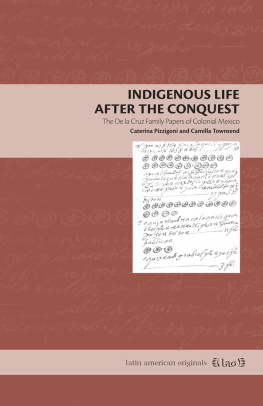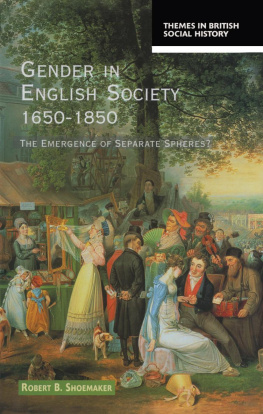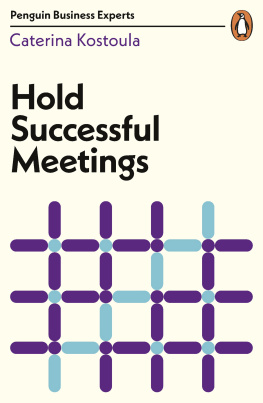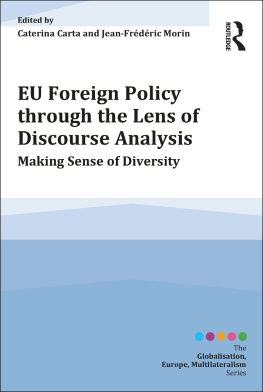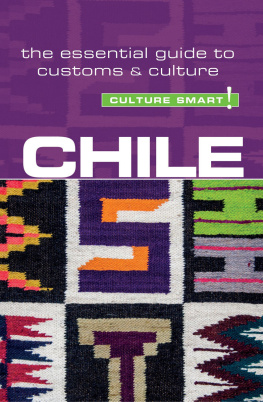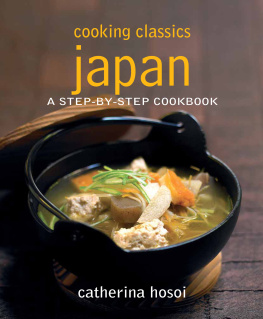Caterina Pizzigoni - The Life Within: Local Indigenous Society in Mexico’s Toluca Valley, 1650-1800
Here you can read online Caterina Pizzigoni - The Life Within: Local Indigenous Society in Mexico’s Toluca Valley, 1650-1800 full text of the book (entire story) in english for free. Download pdf and epub, get meaning, cover and reviews about this ebook. City: Stanford, year: 2013, publisher: Stanford University Press, genre: History / Science. Description of the work, (preface) as well as reviews are available. Best literature library LitArk.com created for fans of good reading and offers a wide selection of genres:
Romance novel
Science fiction
Adventure
Detective
Science
History
Home and family
Prose
Art
Politics
Computer
Non-fiction
Religion
Business
Children
Humor
Choose a favorite category and find really read worthwhile books. Enjoy immersion in the world of imagination, feel the emotions of the characters or learn something new for yourself, make an fascinating discovery.

- Book:The Life Within: Local Indigenous Society in Mexico’s Toluca Valley, 1650-1800
- Author:
- Publisher:Stanford University Press
- Genre:
- Year:2013
- City:Stanford
- Rating:5 / 5
- Favourites:Add to favourites
- Your mark:
- 100
- 1
- 2
- 3
- 4
- 5
The Life Within: Local Indigenous Society in Mexico’s Toluca Valley, 1650-1800: summary, description and annotation
We offer to read an annotation, description, summary or preface (depends on what the author of the book "The Life Within: Local Indigenous Society in Mexico’s Toluca Valley, 1650-1800" wrote himself). If you haven't found the necessary information about the book — write in the comments, we will try to find it.
Caterina Pizzigoni: author's other books
Who wrote The Life Within: Local Indigenous Society in Mexico’s Toluca Valley, 1650-1800? Find out the surname, the name of the author of the book and a list of all author's works by series.
The Life Within: Local Indigenous Society in Mexico’s Toluca Valley, 1650-1800 — read online for free the complete book (whole text) full work
Below is the text of the book, divided by pages. System saving the place of the last page read, allows you to conveniently read the book "The Life Within: Local Indigenous Society in Mexico’s Toluca Valley, 1650-1800" online for free, without having to search again every time where you left off. Put a bookmark, and you can go to the page where you finished reading at any time.
Font size:
Interval:
Bookmark:
Stanford University Press
Stanford, California
2012 by the Board of Trustees of the Leland Stanford Junior University.
All rights reserved.
This book has been published with the assistance of the Department of History, Columbia University.
No part of this book may be reproduced or transmitted in any form or by any means, electronic or mechanical, including photocopying and recording, or in any information storage or retrieval system without the prior written permission of Stanford University Press.
Printed in the United States of America on acid-free, archival-quality paper
Library of Congress Cataloging-in-Publication Data
Pizzigoni, Caterina, author.
The life within: local indigenous society in Mexicos Toluca Valley, 16501800 / Caterina Pizzigoni.
Pages cm
Includes bibliographical references and index.
ISBN 978-0-8047-8137-4 (cloth : alk. paper)
ISBN 978-0-8047-8499-3 (e-book)
1. Indians of MexicoMexicoToluca ValleySocial life and customs17th century. 2. Indians of MexicoMexicoToluca ValleySocial life and customs18th century. 3. Toluca Valley (Mexico)Social life and customs17th century. 4. Toluca Valley (Mexico)Social life and customs18th century. 5. EthnohistoryMexicoToluca Valley. I. Title.
F1219.1.T627P59 2012
972'.53dc23
2011052153
Typeset by Thompson Type in 10/14 Minion
The Life Within
Local Indigenous Society in Mexicos Toluca Valley, 16501800
Caterina Pizzigoni
Stanford University Press
Stanford, California
Contents
Tables and Figures
Tables
Figures
Preface
Fagnano Olona, Lombardia, Italy, May 15, 1915
In the name of God I, being sound of mind, declare that I am issuing the following testament. I request that my funeral be celebrated by ten priests, and that a decent tombstone be placed at the cemetery, where the ground has already been assigned and paid for, and that a requiem mass be said. I want no music, flowers, or coach, but only that those who carry me be paid well. I leave to my nephews Giovanni and Enea Macchi my bed with two mattresses, three pillows, a duvet, a blanket, a wardrobe, a chest of drawers, a bedside table, four chairs, a coffee table, and a mirror. I leave to the poor of Fagnano 49 lire, and to the poor of Bergoro 10 lire. As for my savings in the bank of Gallarate, in the amount of 300 lire, I leave it to my grandniece Francesca, daughter of my nephew Giovanni Macchi, on the condition that it be used for her education in a religious institution. As for the painting of the Holy Family at the head of my bed, I leave it to my nephew Odoardo Fontana.
Cristina Fontana
Widow of Gagliardi
This testament lay there for decades, in the bottom shelf of a wardrobe, forgotten in the buzz of a crowded household. A tin box, and in it a small piece of paper yellowed with time, with the handwriting and seals still visible. Thats all that is left of Cristina Fontana. Gone is the tombstone at the cemetery, gone are the pillows and furniture of her bedroom, which had witnessed so much of life. And where is the painting of the Holy Family? And the people she mentioned? They are all gone, some unexpectedly, before their time, like Francesca, in whom she placed so much hope for a better future, a proper education. Francescas father Giovanni Macchi died after her, his heart broken by the loss of two wives and a daughter in a few years, and he too left a piece of paper behind:
Fagnano Olona, September 23, 1939
With a serene mind I dispose of all I own; I name my children Fausto and Enrica equally as residual heirs. To my son Fausto I leave the business, to my daughter Enrica the furniture that was her deceased mothers, with the mattresses, blankets, linen, and all she brought as her dowry. My son Fausto is not to claim anything else, since he has already received a great deal with the restaurant and hotel.
Giovanni MacchiHotel Garibaldi
Giovanni knew he could trust Fausto, for he had already proven himself in the business. As for Enrica, well, she had always been a bit special. She lived in her own world, not much interested in the one she was passing through, so Giovanni was sure that she wouldnt mind not being put in charge of the hotel and restaurant, but she would never lack material support and shelter.
What would you leave to your children and relatives? What can you? And how would you like your last steps in this world to be? Fausto could not tell his daughter, my mother, about his intentions, nor leave behind a piece of paper that would turn yellow over time. He died of Alzheimers twenty years ago.
The rooms, the objects, the bits of paper at the bottom of a tin box. It is the stuff of life, speaking to us of the lives of the dead, so closely connected with those of the living. From tangible fragments like these a whole world arises. That, ultimately, is what this book is about. As the reader will see, it revolves around testaments of indigenous people written in central Mexico hundreds of years ago in a language unfamiliar to most of us. Yet I cannot help being struck by how much those people were like us today, and that affinity has motivated me and helped me along the way.
...
The living have been behind this book as much as the dead, and quite a few of them, as a matter of fact, so I would like to thank them here. First of all, I thank Jim Lockhart, with whom I started to think of this project some years ago and without whom I would have never finished it. The road has been incredibly exciting, if bumpy at times, and I have learned so much from him and from his generosity. My gratitude and affection are not enough. Thank you, Jim.
Stephanie Wood has shared a great deal of her knowledge about the Toluca Valley and indigenous history and culture that is now reflected in my work, besides providing me with a great mass of invaluable notes and photocopies, in addition to her unwavering support. Camilla Townsend has certainly made the book better with her critical and supportive comments. I am deeply indebted to both for their help and friendship. And I am also indebted to Mark Mairot for giving me access to some most useful Nahuatl testaments he had collected for his dissertation.
I thank my Latin Americanist colleagues and friends here at Columbia, Pablo Piccato, John Coatsworth, Claudio Lomnitz, Nara Milanich, Jos Moya, and in New York, Amy Chazkel, Federico Finchelstein, Paul Gootenberg, and Sinclair Thomson, for the fruitful conversations and the companionship, I keep learning a great deal from them; I am particularly grateful to Pablo for his precious advice, feedback, and friendship since I arrived at Columbia. And I thank Mick Taussig for the insights on interiors, the High Falls retreat, and the constant inspiration. I also thank Adam McKeown for reading my work and Pamela Smith and Neslihan Senocak for the encouragement and support. And special thanks goes to Gerg Baics for helping me with the tables, the map, the broader implications of this project, and more than he probably imagines.
My writing group, Christine Philliou, Amanda Wunder, and Chuck Wooldridge, went patiently through dense versions of the first chapters and reminded me of why it was important to write this book. Ian Robertson was incredibly helpful with the archaeological material, and Michael Smith kindly received me in situ and showed me some of the results of his Calixtlahuaca project. Louise Burkhart, Bob Haskett, and Susan Schroeder have contributed with ideas and encouragement over the years.
I had many conversations with James Dunkerley, on both sides of the Atlantic, and his friendship and faith in me have been invaluable. Linda Newson was always ready to listen to my progress as well as complaints and offered sound advice. Maxine Molyneux received me many times at home and at the Institute for the Study of the Americas. They have been and remain my dear London support group. And I thank Jos Hernndez Palomo for opening his house and the Escuela de Estudios Hispano-Americanos to me and for making my Seville experience such a joy.
Next pageFont size:
Interval:
Bookmark:
Similar books «The Life Within: Local Indigenous Society in Mexico’s Toluca Valley, 1650-1800»
Look at similar books to The Life Within: Local Indigenous Society in Mexico’s Toluca Valley, 1650-1800. We have selected literature similar in name and meaning in the hope of providing readers with more options to find new, interesting, not yet read works.
Discussion, reviews of the book The Life Within: Local Indigenous Society in Mexico’s Toluca Valley, 1650-1800 and just readers' own opinions. Leave your comments, write what you think about the work, its meaning or the main characters. Specify what exactly you liked and what you didn't like, and why you think so.

